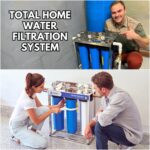Table of Contents
A well-functioning HVAC system (heating, ventilation, and air conditioning) is necessary to maintain a comfortable home environment.
HVAC systems in American homes regulate indoor temperatures year-round, resulting in warmer summers and colder winters.
You can save money and energy while maintaining the comfort and health of your house by taking proper care of your HVAC system.
How to Maintain Your Home HVAC System in the USA?
Understand Your HVAC System Components
Learning the major parts of your HVAC system is important for maintaining it.
- Furnace
In the winter months, this part heats the air. Heat is typically produced by it using electricity, gas, or oil and then spread throughout your house.
- Air Conditioner
In hot weather, this helps to chill the air. Cool air is circulated back into your home as a result of the heat being extracted from the indoor air and released outdoors.
- Heat Pump
This adjustable part can cool and heat your house. Heat is transferred from one location to another to operate. It transfers heat from your home’s interior to the exterior during the summer. It transfers heat from the outside air to the interior throughout the winter.
- Ductwork
These are the routes that hot or cold air takes to get to the various rooms in your house. For effective airflow, ducts must be properly insulated and sealed.
- Thermostat
This is where your HVAC system is controlled. You can adjust the temperature to your preferred setting, and the system will adjust to keep it there.

Regular Maintenance Tasks
A) Changing Air Filters
1. Importance of Clean Air Filters
The performance of your HVAC system and the quality of the air in your house depend on having clean air filters.
Filters that are dirty can limit airflow, making the system work harder and perhaps shortening its lifespan as well as increasing energy costs.
Also, clean filters help prevent pollutants, dust, and allergies from entering your home.
2. How Often to Change Them?
Depending on the kind of filter and the conditions in your home, it is normally advised to replace your air filters every one to three months.
Allergy sufferers or those with pets may require more frequent cleaning.
3. Step-by-Step Guide to Changing Filters
- For safety’s sake, make sure the system is off before proceeding.
- Locate the filter chamber, which is often located next to the air handler or the return air duct.
- With caution, remove the old filter so as not to spread any dust or dirt.
- Make sure the filter you have for your system is the right size and kind.
- Check that the arrows on the filter frame point in the direction of airflow before sliding the replacement filter into the compartment.
- Switch the HVAC system back on after the replacement filter is firmly in place.
B) Cleaning and Clearing Debris
Outdoor units, like heat pumps and air conditioner condensers, are subject to the buildup of dirt, leaves, and other debris.
By keeping these units clean, you can extend the life of your system, avoid overheating, and assure maximum efficiency.
- To prevent problems, ensure the outdoor unit’s electricity is turned off.
- Clear the area surrounding the unit of leaves, twigs, and other debris.
- To carefully clean the fins, use a soft brush or a vacuum with a brush attachment. Take care to avoid bending them.
- Wash the fins gently from the inside out with a garden hose. Pressure washing should be avoided since it may harm the fins.
- To allow for enough airflow, make sure there is at least two feet of room available around the unit.
Read: Water Damage Prevention and Maintenance Tips for USA Homes

C) Inspecting Ductwork
1. Signs of Leaks or Blockages
The effectiveness of your HVAC system can be decreased, and indoor air quality might be impacted, by leaky or clogged ducts.
Indicators to watch out for are,
- Unequal temperature or humidity levels in several rooms
- Increased energy costs
- Dirt or dust that is visible near vents
2. How to Check and Seal Duct Leaks?
- Check the available ductwork for any visible disconnections, gaps, or openings.
- Leaks can be found with an air pressure test or smoke. Experts frequently use these techniques for wide inspections.
- For tiny leaks, use HVAC foils tape or mastic sealant. Do not uses duct tape; it is not very durable.
- To stop energy loss, insulate any ducts that pass through unconditioned areas.
Seasonal Maintenance Tips for Your Home HVAC System
A) Spring and Summer
1. Preparing the AC for Summer Use
It is critical to prepare your air conditioning system for the heat when temperatures climb. Start by looking for any obvious wear or damage on the device.
Run the system to check for proper cooling and listen for any strange noises to ensure everything is operating as it should.
To improve the functioning of the system and encourage proper airflow, clear any debris surrounding the outdoor unit.
2. Checking Refrigerant Levels
Effective cooling requires proper refrigerant levels. Low refrigerant can cause possible system damage as well as decreased cooling efficiency.
To check the levels, you can use a refrigerant gauge or hire a qualified expert to do it for you.
It is necessary to have a technician add more refrigerant and look for any leaks that could be the source of the depletion if it is low.
3. Cleaning Condenser Coils
Condenser coils are essential to the effectiveness of your air conditioner.
They may accumulate dirt and debris over time, which reduces system performance. First, switch off the unit’s power to clean the coils.
After clearing away any visible debris, gently clean the coils with a soft brush or a coil cleaner. Give them a thorough water rinse.
It might be advisable to have a professional clean the coils carefully if they are extremely dirty.
B) Fall and Winter
1. Preparing the Heating System for Winter
Make sure your heating system is operational before the cold season arrives. To begin, visually evaluate the item to look for any indications of wear or damage.
To make sure the heating system is operating properly and heating the space efficiently, run it.
To provide the best possible airflow, remove any debris from the area surrounding the heater and check that all of the vents are clear.
2. Inspecting the Furnace
Having a functional furnace is a necessity for keeping warm in the winter.
Test the furnace for any noticeable issues and make sure the filter is in place. If the filter looks dirty, replace it.
Arrange for a professional inspection to make sure the furnace is in good operating order and is free of any possible issues for a more thorough examination.
Read: Home Maintenance on a Budget – Smart Strategies for USA Homes
3. Checking and Cleaning Heat Exchangers
Heat exchangers are necessary for effective and safe heating.
Frequent cleaning and inspection are necessary to prevent problems like dirt buildup or cracks. Study the heat exchangers closely, and take quick action to fix any damage you find.
To clean, use a brush or a vacuum to get rid of dirt and debris. You might think about hiring a professional for complete cleaning and maintenance.
How to Optimize Your HVAC System for Energy Efficiency?
- Regular Maintenance
Plan yearly HVAC system maintenance with a professional and this includes sanitizing, studying, and fine-tuning the system to guarantee optimal performance.
- Upgrade Your System
If your HVAC system is old, think about replacing it with a more energy-efficient model. Modern models can save a substantial amount of energy because they are made to be more efficient.
- System Zoning
To just heat or cool the areas that are being used, install zoning systems. This keeps energy from being wasted on empty places.
- Airflow Management
Make that the airflow flows freely and that the air ducts are correctly sealed. This lessens energy loss and helps to maintain constant temperatures.
Use Programmable Thermostats
- Set Schedules
With programmable thermostats, you can create customized heating and cooling plans according to your daily activities. As an illustration, you could program the thermostat to drop when you leave for work and rise when you get home.
- Temperature Adjustments
Change the temperature on the thermostat a few degrees. Considerable energy savings can result from winter temperatures that are lower and summer temperatures that are higher.
- Remote Control
Nowadays, a lot of programmable thermostats include smartphone apps that let you control the thermostat remotely and keep an eye on your energy usage from any location.
Basic Troubleshooting Steps
- Check the Thermostat
Make sure the thermostat is operating properly and is set to the proper temperature. In case it is needed, change the batteries.
- Inspect Air Filters
Airflow can be slowed and efficiency might be decreased by dirty or clogged air filters. Regularly inspect and replace filters.
- Clear Debris
Make sure that filters and vents are not blocked and clear any debris from the area surrounding the outdoor unit.
- Reset the System
Sometimes small problems can be fixed by just resetting the HVAC system. After shutting down the machine, give it a few minutes, and then restart it.
Bottom Line
For your home to remain comfortable, efficient, and long-lasting, you must maintain your HVAC system.
Along with preventing unplanned problems, routine maintenance also lowers energy costs and creates a healthier interior environment.
Read: How to Properly Ventilate Your Home to Prevent Moisture Buildup?











